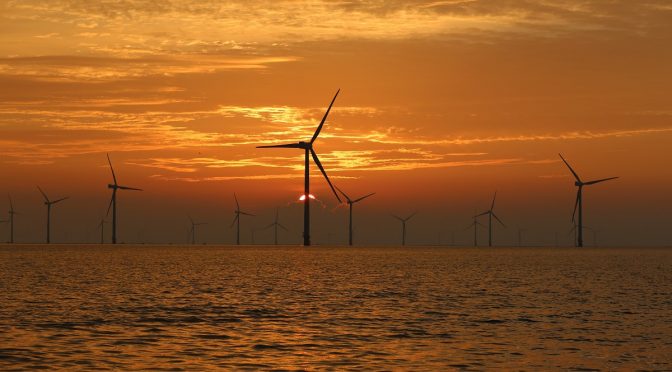In 2020, China broke the world record for most wind energy capacity installed in a single year with 52 GW of new capacity – double the country’s annual installations compared to the previous year.
Overall, nearly 56 GW of new wind power capacity was installed in the Asia Pacific region in 2020, a 78 per cent year-on-year increase.
The Asia Pacific region is increasingly driving growth of the global wind energy industry, with the region accounting for 60 per cent of all new wind power capacity in 2020.
Total wind power capacity in Asia Pacific is now nearly 347 GW, making it the region with the most wind power capacity worldwide and helping to avoid 510 million tonnes of C02 emissions annually – equivalent to taking 110 million passenger cars off the road.
- According to the latest data released by GWEC Market Intelligence, 2020 was a record year for wind power growth in the Asia Pacific. This growth was driven by China, which installed 52 GW of new wind power capacity in 2020 according to initial data – double what the country installed in 2019 and more capacity installed in a single year by any country in history.
In addition to China, Australia (1,097 MW), Japan (449 MW), Kazakhstan (300 MW), and Sri Lanka (88 MW) all had record years for wind power in 2020. Although India (1,119 MW) ranked second in terms of new wind power capacity in the region in 2020, last year was the lowest year on record for new wind installations for the country since 2004 due to regulatory and infrastructure bottlenecks.
Altogether, the region installed 56 GW of new wind power capacity in 2020, a 78 per cent year-on-year increase and nearly the same capacity that was installed globally in 2019. This brings total capacity in the region to nearly 347 GW, which helps to avoid 510 million tonnes of CO2 emissions annually – equivalent to taking 110 million passenger cars off the road.
Feng Zhao, Head of Market Intelligence and Strategy at GWEC commented: “Asia Pacific is the region with the most wind power capacity globally, with the region installing over 60 per cent of all new global wind power capacity in 2020. The incredible and rapid growth of wind power in the region has been led by China, which now has more wind power capacity than Europe, Africa, the Middle East, and Latin America combined. We were expecting an installation rush in China last year due to the phase out of the onshore wind Feed-in-Tariff by the end of 2020, but the Chinese wind market exceeded our original forecasts by over 73 per cent.”
“In order for China to achieve its goal of net zero by 2060, the country needs to be installing over 50 GW of wind power capacity per year from 2021-2025, and 60 GW from 2026 onwards. Although installation levels were on track with these targets in 2020, China now must ensure that this level of growth can be sustained in a subsidy-free era”, he added.
The incredible and rapid growth of wind power in the region has been led by China, which now has more wind power capacity than Europe, Africa, the Middle East, and Latin America combined. Feng Zhao, Head of Market Intelligence and Strategy, GWEC Tweet
Martand Shardul, Policy Director at GWEC India commented: “While it was a record year for wind power in the Asia Pacific region, India’s wind power markets experienced a slowdown in 2020, adding less than half of the capacity that was installed in 2019. Although COVID-19 may have contributed to the slowdown, we have been witnessing a deceleration of market momentum in India since 2018 due to policy, infrastructure, and regulatory challenges. Solving these challenges through collaboration between the private and public sector will be key to make India a wind power leader in the region once again and power a green recovery.”
Solving these challenges through collaboration between the private and public sector will be key to make India a wind power leader in the region once again and power a green recovery. Martand Shardul, Policy Director, GWEC India Tweet
Liming Qiao, Head of GWEC Asia added: “We are beginning to see new wind power markets emerge in the Asia Pacific region, especially in South East Asia, which will become increasingly important growth drivers for the wind industry over the next decade. Markets such as Vietnam have massive wind power potential, but getting the right regulatory frameworks in place will be key to provide a long-term horizon for the market and attract investors.”.
“With major economies in the region, including China, South Korea, Japan, and New Zealand, setting ambitious net zero targets, both onshore and offshore wind will need to play a crucial role in helping the Asia Pacific region achieve carbon neutrality. This will not only help countries decarbonise, but will help create greater energy security in the region by reducing the import of expensive fossil fuels while creating opportunities for new investment and jobs”, she added.
With major economies in the region, including China, South Korea, Japan, and New Zealand, setting ambitious net zero targets, both onshore and offshore wind will need to play a crucial role in helping the Asia Pacific region achieve carbon neutrality. Liming Qiao, Head of GWEC Asia
New Wind Power Capacity in the Asia Pacific in 2020
- China – 52,000 MW
- India – 1,119 MW
- Australia – 1,097 MW
- Japan – 449 MW
- Kazakhstan – 300 MW
- South Korea – 160 MW
- Vietnam – 125 MW
- New Zealand – 103 MW
- Sri Lanka – 88 MW
- Taiwan – 74 MW
- Pakistan – 48 MW
Top 5 Wind Markets the Asia Pacific for Cumulative Capacity
- China – 288,320 MW
- India – 38,625 MW
- Australia – 7,296 MW
- Japan – 4,336 MW
- South Korea – 1,648 MW


